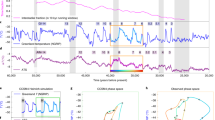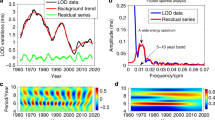Abstract
Over the past million years, glacial–interglacial cycles have had a period of about 100,000 years, similar to the 100,000-year period of change in the eccentricity of the Earth’s orbit. However, the change in incoming solar radiation—insolation—at this timescale is small, and therefore difficult to reconcile with the amplitude of the glacial cycles1,2,3,4,5. This issue, known as the 100-kyr problem, is compounded by a lack of explanation for the transition of the length of the cycles from 41,000 to 100,000 years at the mid-Pleistocene transition 1.2 million years ago6. Individual discrepancies have been explained, for example, through interactions between other orbital frequencies such as obliquity and the 413,000-year period of eccentricity3,4,5,6,7,8,9,10,11,12,13, but a unified explanation is lacking. Here we show that climate oscillations over the past four million years can be explained by a single mechanism: the synchronization of nonlinear internal climate oscillations and the 413,000-year eccentricity cycle. Using spectral analyses aided by a numerical model, we find that the climate system first synchronized to the 413,000-year eccentricity cycle about 1.2 million years ago and has remained synchronized ever since. This synchronization results in a nonlinear transfer of power and frequency modulation that increases the amplitude of the 100,000-year cycle. We conclude that the forced synchronization can explain the strong 100,000-year glacial cycles through the alignment of insolation changes and internal climate oscillations.
This is a preview of subscription content, access via your institution
Access options
Subscribe to this journal
Receive 12 print issues and online access
$259.00 per year
only $21.58 per issue
Buy this article
- Purchase on Springer Link
- Instant access to full article PDF
Prices may be subject to local taxes which are calculated during checkout




Similar content being viewed by others
References
Lisiecki, L. Links between eccentricity forcing and the 100,000-year glacial cycle. Nature Geosci. 3, 349–352 (2010).
El-Kibbi, M. & Rial, J. A. An outsider’s review of the astronomical theory of the climate. Earth Sci. Rev. 56, 161–177 (2001).
Huybers, P. & Wunsch, C. Obliquity pacing of the late Pleistocene glacial terminations. Nature 434, 491–494 (2005).
Raymo, M. E. The timing of major climate terminations. Paleoceanography 12, 577–585 (1997).
Berger, A., Melice, J. L. & Loutre, M. F. On the origin of the 100-kyr cycles in the astronomical forcing. Paleoceanography 20, PA4019 (2005).
Clark, P. U. et al. The Middle Pleistocene transition: Characteristics, mechanisms, and implications for long-term changes in atmospheric p CO 2 . Quat. Sci. Rev. 25, 3150–3184 (2006).
Saltzman, B. Dynamical Paleoclimatology (Academic, 2002).
Rial, J.A. Pacemaking the ice ages by frequency modulation of Earth’s orbital eccentricity. Science 285, 564–568 (1999).
Pisias, N. G. & Moore, T. C. Jr The evolution of the Pleistocene climate: A time series approach. Earth Planet. Sci. Lett. 52, 450–458 (1981).
Paillard, D. The timing of Pleistocene glaciations from a simple multiple-state climate model. Nature 391, 378–381 (1998).
Muller, R. & McDonald, G. Ice Ages and Astronomical Causes: Data, Spectral Analysis and Mechanisms (Springer, 2000).
Oerlemans, J. Milankovitch and Climate, Part 2 (Berger, A. L. et al.) 607–611 (1984).
Tziperman, E., Raymo, M., Huybers, P. & Wunsch, C. Consequences of pacing the Pleistocene 100kyr ice ages by nonlinear phase locking to Milankovitch forcing. Paleoceanography 21, PA4206 (2006).
Pikovsky, A., Rosenblum, M. & Kurths, J. Synchronization. A Universal Concept in Nonlinear Sciences (Cambridge Nonlinear Science Series, Vol. 12, Cambridge Univ. Press, 2002).
Balanov, A., Janson, N., Postnov, D. & Sosnovtseva, O. Synchronization, From Simple to Complex (Springer, 2009).
Rial, J. A. Synchronization of polar climate variability over the last ice age: In search of simple rules at the heart of climate’s complexity. Am. J. Sci. 312, 417–448 (2012).
Gonzalez-Miranda, J. M. Synchronization and Control of Chaos (Imperial College Press, 2004).
Lisiecki, L. E. & Raymo, M. E. A Pliocene–Pleistocene stack of 57 globally distributed benthic 18O records. Paleoceanography 20, PA1003 (2005).
Huybers, P. & Wunsch, C. A depth-derived Pleistocene age-model: Uncertainty estimates, sedimentation variability, and nonlinear climate change. Paleoceanography 19, PA1028 (2004).
Ghil, M. & Childress, S. Topics in Geophysical Fluid Dynamics, Atmospheric Dynamics, Dynamo Theory and Climate Dynamics (Springer, 1987).
Van der Pol, B. Frequency Modulation. Proc. Inst. Radio Eng. 18, 1194–1205 (1930).
Lathi, B. P. & Ding, Z. Modern Digital and Analog Communication Systems (Oxford Univ. Press, 2009).
Ghil, M. et al. Advanced spectral methods for climatic time series. Rev. Geophys. 40, 3-1–3-41 (2002).
Huang, N. E. et al. The empirical mode decomposition and the Hilbert spectrum for nonlinear and non-stationary time series analysis. Proc. R. Soc. Lond. A454, 903–995 (1998).
Gabor, D. Theory of communication. J. IEE III 93, 429–444 (1946).
Lisiecki, L. E. & Raymo, M. Plio–Pleistocene climate evolution: Trends and transitions in glacial cycle dynamics. Quat. Sci. Rev. 26, 56–69 (2007).
Nie, J. Coupled 100-kyr cycles between 3 and 1 Ma in terrestrial and marine paleoclimatic records. Geochem. Geophys. Geosyst. 12, Q10Z32 (2011).
Nie, J., King, J. & Fang, X. Late Pliocene–early Pleistocene 100-ka problem. Geophys. Res. Lett. 35, L21606.
Bracewell, R. The Fourier Transform and its Applications (McGraw-Hill, 1986).
Berens, P. CircStat: A Matlab toolbox for circular statistics. J. Stat. Software 31, 1–21 (2009).
Acknowledgements
This research is supported by grants from the J. S. McDonnell Foundation (21st Century Science Initiative on Complex systems) and the National Science Foundation (Paleoclimate and P2C2 programmes). We are grateful to J. Nie who alerted us to the evidence for natural frequencies of oscillation in the ∼ 100- and 500-kyr bands and offered thoughtful comments. L. Lisiecki generously provided the LR04 untuned record and provided important comments that improved the original manuscript.
Author information
Authors and Affiliations
Contributions
J.A.R. developed the concept and wrote the original manuscript. J.O. tested results and calculated the statistics, E.R. wrote needed computer codes and revised the original manuscript.
Corresponding author
Ethics declarations
Competing interests
The authors declare no competing financial interests.
Supplementary information
Supplementary Information
Supplementary Information (PDF 8417 kb)
Rights and permissions
About this article
Cite this article
Rial, J., Oh, J. & Reischmann, E. Synchronization of the climate system to eccentricity forcing and the 100,000-year problem. Nature Geosci 6, 289–293 (2013). https://doi.org/10.1038/ngeo1756
Received:
Accepted:
Published:
Issue Date:
DOI: https://doi.org/10.1038/ngeo1756
This article is cited by
-
The Mid-Pleistocene Transition: a delayed response to an increasing positive feedback?
Climate Dynamics (2023)
-
Timing Terminators: Forecasting Sunspot Cycle 25 Onset
Solar Physics (2020)
-
Bayesian Data Analysis for Revealing Causes of the Middle Pleistocene Transition
Scientific Reports (2019)
-
The middle Pleistocene transition by frequency locking and slow ramping of internal period
Climate Dynamics (2019)
-
Forcing of late Pleistocene ice volume by spatially variable summer energy
Scientific Reports (2018)



